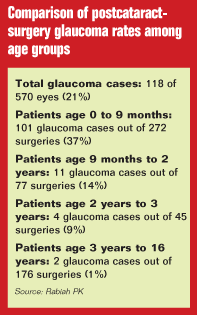Screen for glaucoma after cataract surgery in young patients
Nine months appears to be a threshold age, researcher found.
 |
Children who undergo cataract surgery at or before 9 months of age are more likely to develop postcataract-surgery glaucoma than children operated on at later ages, according to a retrospective study.
Peter K. Rabiah, MD, an ophthalmologist at the King Khaled Eye Specialist Hospital, Saudi Arabia, reviewed the records of 322 children age 16 years or younger who underwent cataract removal in at least one eye and had a minimum of 5 years follow-up.
“An apparent threshold age at cataract surgery for the development of later glaucoma appeared to exist at 9 months; patients operated on at or before this age frequently developed glaucoma, whereas patients operated on after this age infrequently developed glaucoma,” he said.
Although the children had a mean age of 2.9 ± 3.8 years at the time of cataract removal, 86% of post-surgery glaucoma cases were in children who had undergone surgery at or before 9 months of age.
Dr. Rabiah noted that this high rate may be due to the study’s length of follow-up, which underscores the importance of continued long-term screening of such patients.
Exclusions
Dr. Rabiah excluded from the study any children with preoperative ocular abnormalities other than cataract. However, children with microcornea were included because it is a common finding among such children and has been believed to be predictive of postoperative glaucoma.
The study excluded children with any preoperative signs of glaucoma, including those with preoperative IOP of 22 mm Hg or greater. Also excluded were children implanted with a primary IOL.
Children were diagnosed with postcataract-surgery glaucoma if they had an IOP of 26 mm Hg or higher on at least two occasions. Dr. Rabiah noted the diagnosis was based only on IOP, and the relatively high cutoff level of 26 mm Hg was chosen to increase the likelihood that identified patients had glaucoma.
Younger patients, more glaucoma
Out of 570 eyes of 322 children, 118 cases of glaucoma were diagnosed at a mean of 5.4 ± 3.1 years postoperatively. Mean IOP was 34 ± 7 mm Hg at the time of glaucoma diagnosis and ranged from 26 mm Hg to 54 mm Hg.
According to the study, 272 eyes were operated on at or before 9 months of age. Of these eyes, 101 (37%) later developed postcataract-surgery glaucoma. Dr. Rabiah noted that these 101 eyes represented 86% of the 118 glaucoma cases. The remaining 17 cases had undergone surgery between ages 10 months and 6 years.
Overall, children who later developed glaucoma had a mean age of 0.6 ± 0.8 years at the time of surgery while children who did not develop glaucoma had a mean age of 3.6 ± 4 years.
Of the 322 children included in the study, 248 underwent bilateral cataract surgery and met study eligibility criteria for both eyes. Of these, 65 developed glaucoma in at least one eye — 50 (77%) had bilateral postcataract-surgery glaucoma and 15 (23%) had unilateral postcataract-surgery glaucoma.
Glaucoma was simultaneously diagnosed in both eyes in 32 of the 50 children with bilateral glaucoma (64%), while the other 18 cases were diagnosed over a 4.8-year interval.
No unoperated fellow eyes developed glaucoma, Dr. Rabiah noted.
For Your Information:Reference:
- Peter K. Rabiah, MD, can be reached at Glenbrook Eye & Vision Center, 2050 Pfingsten Road, Suite 280, Glenview, IL 60025 U.S.A.; +1-847-657-1860; fax: +1-847-657-1890; e-mail: prabiah@enh.org.
- Rabiah PK. Frequency and predictors of glaucoma after pediatric cataract surgery. Am J Ophthalmol. 2004;137:30-37.
